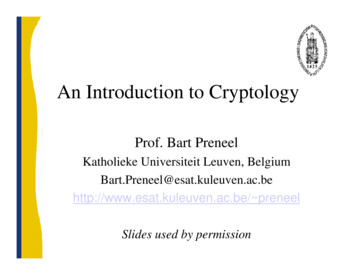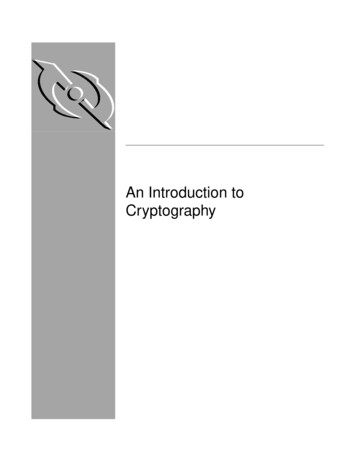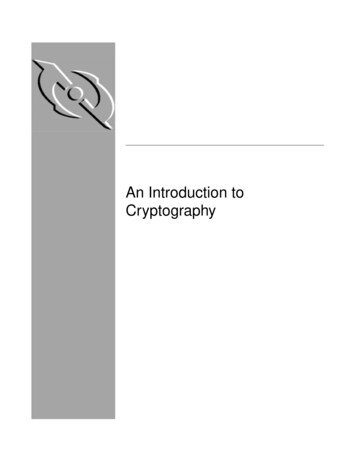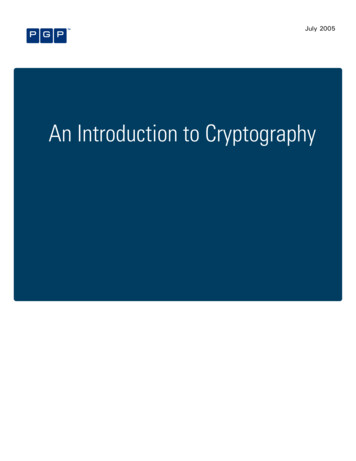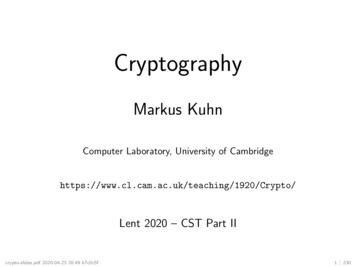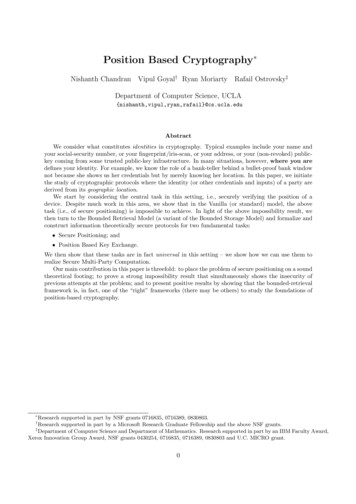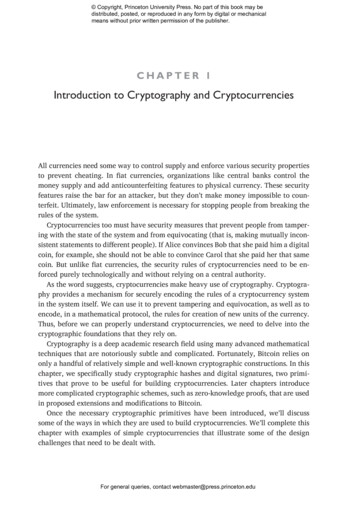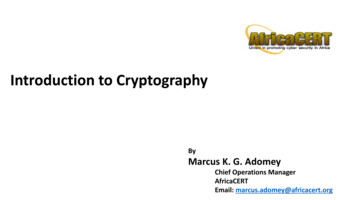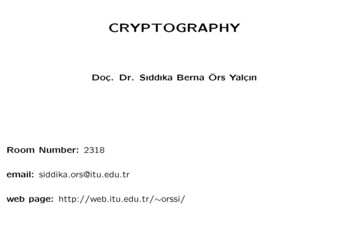
Transcription
CRYPTOGRAPHYDoç. Dr. Sıddıka Berna Örs YalçınRoom Number: 2318email: siddika.ors@itu.edu.trweb page: http://web.itu.edu.tr/ orssi/
References1. Douglas R. Stinson, Cryptography Theory and Practice, Third Edition,CRC Press, November 2005.2. Alfred J. Menezes, Paul C. van Oorschot and Scott A. Vanstone, Handbookof Applied Cryptography, CRC Press, ISBN: 0-8493-8523-7, October 1996,816 pages.
Content1. Classical cryptography: introduction: some simple cryptosystems2. Cryptanalysis of simple cryptosystems3. Shannon’s theory: probability theory, entropy, properties of entropy4. Product cryptosystems5. Block ciphers: substiturion-permutation network6. Linear cryptanalysis7. Differential cryptanalysis8. The data encryption standard (DES)9. Advanced encryption standard (AES), modes of operation10. Hash functions: collision-free hash functions, authentication codes11. The RSA system and factoring: introduction to public-key cryptography12. Public-key cryptosystems based on discrete logarithm problem: the ElGamalcryptosystem13. Finite field and elliptic curve systems14. Signature schemes: introduction, the ElGamal signature scheme15. The digital signature algorithm (DSA), the elliptic curve digital signaturealgorithm (ECDSA)
Grading1st Homework1st Midterm2nd Homework2nd Midterm3rd HomeworkFinal2-5th week6th week7-10th week11th week12th week-final exam151515151540%%%%%%
History of Cryptographyhieroglyphs - around 2000 B.C.ideogram - ancient IHGFEDCBAClay tablets from MesopotamiaAtbash cipher - around 500 to 600 BC12345Scytale - Spartan1AFKPU2BGLQV3CHMRW4DINSX5EJOTY/ZPolybius Square - Greek method
Steganography physically concealed beneath wax on wooden tablets a tattoo on a slave’s head concealed by regrown hair
Usage of Cryptography Past– Military, Diplomatic Service, Government– was used as a tool to protect national secrets and strategies Now– Private sector– is used to protect information in digital form and to provide securityservices
CRYPTOGRAPHY is the study of mathematical techniques related to aspects of informationsecurity such as– confidentiality,– data integrity,– entity authentication,– data origin authentication. is about the prevention and detection of cheating and other malicious activities.
Basic Terminology: DomainsThe cryptosystem is a five- tuple P, C, K, E, D P: a set called the plaintext space. C: a set called the ciphertext space. K: a set called the key space. For each K K, there is an encryption rule eK E and a correspondingdecryption rule dK D. Each eK : P C and dK : C P are functions suchthat dK (eK (x)) x for every element x P.
Shift Cipher Let P C K Z26. For 0 K 25, define eK (x) (x K) mod 26 anddK (y) (y K) mod 26 Since there are only 26 possible keys, it is easy to try every possible K untila meaningful plaintext is obtained. K 3 is called Ceaser cipher ( 55 BC)
Caesar UVWXYZABExample 1 :x y eK (x) ECUREHFXUH
CryptanalysisThe practice of changing ciphertext into plaintext without complete knowledgeof the cipher.First method : Frequency analysis - Arabic author, QalqashandiIf a cryptosystem is to be of practical use:1. Each eK and dK should be efficiently computable.2. An opponent, upon seeing a ciphertext string y should be unable to determine the key K or the plaintext string x.
Types of Attacks (1/2)Kerckhof’s principle:the attacker has full knowledge of the encryption algorithm, and only the key of the cryptosystem is unknown.The aim of the attacker is to read the encrypted messages, which in manycases is achieved by finding the secret key of the system.The efficiency of the attack is measured by the amount of plaintext- ciphertext pairs required, time spent for their analysis the success probability of the attackUsually the starting point of a cryptanalytic attack is the ability, to distinguishthe output of a cipher from the output of a random permutation.
Types of Attacks (2/2) Ciphertext- Only Known Plaintext Chosen Plaintext Chosen Ciphertext Adaptive Chosen Plaintext or Ciphertext Related Key Partial Knowledge of the Key
The Goals of Cryptanalytic Attacks (1/2) Distinguishing Attacks Partial Knowledge of the Plaintext Decryption Encryption (Forgery) Partial Key Recovery Total Key Recovery
The Goals of Cryptanalytic Attacks (2/2)The cipher can be considered broken if: its output can be distinguished from a random permutation the secret key is found it is possible to derive secret elements of a cipherA cipher is broken, if a person who uses it decides to stop doing so becausehe/she does not trust its security anymore.People expect that a good cipher is a one for which the best attack is anexhaustive search for the key.A cipher is considered broken if a weakness in it is found which requires thechanges of the design.
Cryptology Exhaustive search: trying all possible keys Cryptanalysis: the study of mathematical techniques to break the system Cryptology: cryptography cryptanalysis Cryptosystem: a set of cryptographic primitives, symmetric key and publickey
Cryptanalysis of Example TYNOTSGEWTGFDVSFECUREK 3
Mono- alphabetic Substitution Cipher Let P C Z26. K consists of all possible permutations of the 26 symbols.For each permutation π K, defineeπ (x) π (x) and dπ (y) π 1 (y ) where π 1 is the inverse permutation toπ. If the alphabet is the English alphabet, then the size of the key space is26! 4 1026 The distribution of letter frequencies is preserved in the ciphertext.
Exampleπ AB CDEFGHI J KL MNOPQRS T U VWX YZBDF H J LNPRTVXZ BE GI KMOQS U WAYm c eπ (m) ECUREJFQKJ
Cryptanalysis of Mono- alphabetic Substitution ZOHUWTZYQBZYQBOLetter Frequency in the English LanguageE T A O I N S R H L D C U M F P G W Y B V K X J Q ZLetter Frequency in the ciphertextA B CDEFGH I J KLMNOPQRSTUVWX Y Z0 13 0 2 1 0 3 7 0 0 3 2 2 1 4 1 9 2 0 4 6 6 4 2 13 7eπ (E) B or Y and eπ (T) B or Y
Cryptanalysis of Mono- alphabetic Substitution Cipher(2/8)Digraphs in the ciphertext with B--QBQ- - - - - - - - - - - - - - - WBU- - - - - - - - - QBN- - YBV- - - QBO- - - - - - - - - - - - - - - - - - - QBZ- WBO- - - QBKBYYBO- - QBH- - - - MBY- - - - - - - - - - - - - - - - - MBP- WBZ- - - - - UBN- - QBT- - WBR- - QBO- QBTBH- - LBY- - - QBV- PBH- QBT- - - - - - - - - - - - - YBYQBG- - - - - KBYYBO- - - QBH- MBY- - PBK- - - - - - - - - - QBZ- QBO-The Digraph Frequencies in the English Languageth he an in er on re ed nd ha at en es of nt ea ti to io le is ou ar as de rt veDigraph Frequency in the ciphertext with BBG BH BK BN BO BP BR BQ BT BU BV BY BZ KB LB MB PB QB1 4 12 6 1 1 1 3 1 2 6 3 2 1 3 2 15TB UB WB YB1 1 44eπ (HE) QB eπ (H) Q eπ (ER) BO or BY eπ (R) O or Y
Cryptanalysis of Mono- alphabetic Substitution Cipher(3/8)The Trigraph Frequencies in the English Languagethe and tha ent ion tio for nde has nce tis oft menTrigraphs in the ciphertext such as xQB and Byz- GQB- - - - - - - - - - - - - - - - - BUY- - - - - - - XQBNO- - BVY- - - EQBOY- - - - - - - - - - - - - - - - - YQBZO- - - - - YQB- - - - BOT- - YQBHK- - - - - - - - - - - - - - - - - - - - - - - - BPH- BZD- - - - - - - BNVTQBTY- - BRV- - - - YQB- BHU- - BYH- YQBVO- BHU- - LQB- - - - - - - - - - - - - - - BYQBGZ- - - - - - - - BOZ- YQBHK- - - - BYU- - BKX- - - - - - - - YQB- YQBOTThe Trigraph Frequencies in the ciphertext such as xQB and ByzBGZ BHK BHU BKX BNO BNV BOT BOY BOZ BPH BRV12111121111eπ (THE) YQB eπ (T) Y eπ (R) Oeπ (ENT) BTY or BUY or BVY eπ (N) T or U or VBTY1
Cryptanalysis of Mono- alphabetic Substitution Cipher(4/8)Digraphs in the ciphertext with Y- - - - - - - - - XYQ- - - - - - - - - - UYV- KYZ- - - - - - - ZYBVYV- - - - - OYQHYV- - - - - - - - - - - - LYQ- - - - - - - GYQ- - BYYB- - GYQ- - - - - - - BYYQHYUZYH- - - - - - - - - - - - - - - - DYV- - - - - - - - - - - TYZ- - - - - - - OYQ- - - - - - - BYHYYQ- - - - - - - - - - - - - - - - - - - - TYVYDYBYQ- - - - OYQ- BYYB- - GYQ- - - - - - BYU- - - - - - - - - - - - ZYQ- ZYQ- - Digraph Frequency in the ciphertext with YBY DY HY GY KY OY TY UY VY XY YB YD YH YQ YU YV YZ ZY4 2 2 1 1 3 2 1 2 1 3 1 1 9 2 4 2 4eπ (TH) YQ eπ (ET) BY eπ (TI or TO) YV
Cryptanalysis of Mono- alphabetic Substitution Cipher(5/8)Trigraphs in the ciphertext such as Yxy- - - - - - - - - - YQV- - - - - - - - - - YVH- - - - - - - - - - - YBVYVU- - - - - - YQHYVT- - - - - - - - - - - - - - - - - - - - - - - - - - - - - - - - - - - - - - - - - - - - YQHYUZYHN- - - - - - - - - - - - - - - - YVG- - - - - - - - - - - YZW- - - - - - - - - - - - - - - - - YHY- - - - - - - - - - - - - - - - - - - - - - - YVYDY- - - - - - - - YQK- - - - - - - - - - - - - - - - YUH- - - - - - - - - - - - - - - - - - - - The Trigraph Frequencies in the ciphertext such as YQx and YxyYBV1YDY1YHN1YHY1YQV1YQH2YQK1YUH1eπ (THA) YQH eπ (A) Heπ (TIO or TIS) YVG or YVT or YVU eπ (I) VYUZ1YVG1YVH1YVT1
Cryptanalysis of Mono- alphabetic Substitution Cipher(6/8)Digraphs in the ciphertext with H- - - - - HWHU- - - - - - - - - - - - - - - VHK- - THX- - - - - - - - - - - - - - - - - - HY- - - - - - - - HU- - - - - - - - - - - - - - - - - - - - - - - - - - - - HK- - HM- - - - - - - - - HN- - - - - - - - - - PHW- - - - - GHU- - - - - - - - - - - - - - - - - - - - - - - - - HU- - - - HY- - - - - - - HU- - - - - - - - - - - - - - - - - - - - - - - - - - - - - - - - - - - - - - - - - HK- - HM- - UHP- - - - - - HUDigraph Frequency in the ciphertext with HGH HK HM HN HP HU HW HX HY PH1321152121TH1UH1eπ (AN) HU eπ (N) UThe Trigraph Frequencies in the ciphertext such as HUxHUL HUW HUV HUX1212eπ (AND) HUW or HUX eπ (D) W or XWH1VH1
Cryptanalysis of Mono- alphabetic Substitution Cipher(7/8)B E, Y T, Q H, O R, H A, V I, W DI- HEHADA- - THI- - - - - - IDE- TIA- T- - A- HE- R- TEITIVGQBQHWHUXYQVULRZUGVWBUYVHKYZTHXQBNOZYBVYVU- I- HERTHATI- - - - - - HA- - I- - THE- RDER- - THE- ETTERRVEQBOYQHYVTMXTZRQHULVULYQBZOWBOZGYQBKBYYBO- - - THEA- - HA- ETTHAT- - TA- - RD- - - - D- E- ADE- - TI- ATZGYQBHKEQHMBYYQHYUZYHNZOWRZDKWMBPHWBZDYVGH- - - - E- I- HE- T- DE- I- HERTHE- EA- D- ETATTHEIR- EAUXZUBNVTQBTYZWBRVEQBOYQBTBHUWLBYHYYQBVOPBHUI- - HE- H- - - D- - - - TIT- TETHE- - - RTH- ETTER- - THEAVULQBTQZDKWTDMTYVYDYBYQBGZDOYQKBYYBOZGYQBHK- HA- ET- A- E- - - - RA- D- - THE- THER-
Cryptanalysis of Mono- alphabetic Substitution Cipher(8/8)K L, Z O, G F, D U, T S, M B, E P, R C, U N, X Y, L G, N W, R C, P OTHEOTHERSIF HE HAD ANYTHING CONFIDENTIAL TO SAY HE WROTE IT IN CIPHER THAT IS BY SO CHANGING THE ORDER OF THE LETTERS OFTHE ALPHABET THAT NOT A WORD COULD BE MADE OUT IF ANYONE WISHES TO DECIPHER THESE AND GET AT THEIR MEANINGHE SHOULD SUBSTITUTE THE FOURTH LETTER OF THE ALPHABETNAMELY FOR AND SO THE OTHERS
Affine Cipher (1/2)Let P C Z26 and letK {(a, b) Z26 Z26 : gcd(a, 26) 1} .For K (a, b) K, defineeK (x) y (ax b) mod 26 and dK (y) x a 1 (y b) mod 26 .In order that decryption is possible, for any y Z26, y (ax b) mod 26 musthave a unique solution for x gcd(a, 26) 1
Affine Cipher (2/2)y (ax b) mod 26 is equivalent to y b mod 26 ax mod 26As y Z26, y b mod 26 Z26.It suffices to study the congruence y ax mod 26.If gcd(a, 26) d 1, then 0 ax mod 26 has to distinct solutions in Z26,namely x 0 and x 26d .In this case e(x) ax b mod 26 is not an injective function and hence not avalid encryption function.Since 26 2 13, a 1, 3, 4, 7, 9, 11, 15, 17, 19, 21, 23, 25, b can be any elementin Z26. Hence affine cipher has 12 26 312 possible keys.
Multiplicative Inversea Zn, multiplicative inverse of a mod n, denoted a 1 mod n. aa 1 1 mod n .If p is prime, then every non- zero element of Zp has a unique multiplicativeinverse.Algorithm 1 Multiplicative InverseRequire: a Zn, n is a positive integerEnsure: a 1 mod n1: Use the extended Euclidean algorithm to find integers x and y such thatax ny d, where d gcd(a, n) .2: If d 1, then a 1 mod n does not exist. Otherwise return x .
Extended Euclidean (1/2)Algorithm 2 Extended EuclideanRequire: two non- negative integers a and b with a b .Ensure: d gcd(a, b) and integers x, y satisfying ax by d .1: If b 0 then set d a, x 1, y 0 and return (d, x, y ) .2: Set x2 1, x1 0, y2 0, y1 1 .3: while b 0 do4:q ⌊ ab ⌋, r a qb, x x2 qx1, y y2 qy1 .5:a b, b r, x2 x1, x1 x, y2 y1 and y1 y .6: end while7: Set d a, x x2, y y2 and return (d, x, y ) .
Extended Euclidean (2/2)Example gcd(81, 57) ?81572496 5724963·····12212 2496381x 57y 33 9- 63 9- (24- 9 · 2) · 1 9 · 3- 243 (57- 24 · 2) · 3- 24 57 · 3- 24 · 73 57 · 3- (81- 57) · 7 81 · - 7 57 · 10
Cryptanalysis of the Affine Cipher HERMFKDQRMZYEDPRLetter Frequency in the English LanguageE T A O I N S R H L D C U M F P G W Y B V K X J Q ZLetter Frequency in the ciphertextABCDEFGH I J KLMNOPQ R STUVWXYZ6 0 0 8 8 8 0 5 1 0 6 4 4 3 4 2 0 16 8 2 2 2 0 1 2 0
Cryptanalysis of the Affine Cipher (2/3)Ee(E) R 17 a4 b mod 26Ee(T) D 3 a19 b mod 26 then a 6, gcd(6, 26) 2 1.Ee(T) E 4 a19 b mod 26 then a 13, gcd(13, 26) 13 1.Ee(T) F 5 a19 b mod 26 then a 20, gcd(20, 26) 2 1.Ee(T) S 18 a19 b mod 26 then a 7, gcd(7, 26) 1 and b 9.Decrypted TGRDOMQ
Cryptanalysis of the Affine Cipher (3/3)Ee(T) K 10 a19 b mod 26 then a 3, gcd(7, 26) 1 and b 5.Decrypted LYPRIMETHIS CALCULATOR ENCIPHERS AND DECIPHERS TEXT USING AN AFFINECIPHER IN WHICH LETTERS ARE ENCODED USING THE FORMULAWHERE AND ARE WHOLE NUMBERS BETWEEN AND AND IS RELATIVELY PRIME
Alberti CipherAll of the Western European governments used cryptographyVenice created an elaborate organization in 1452.Leon Battista Alberti was known as ”The Father of Western Cryptology” inpart because of his development of polyalphabetic substitution.FormulaThe larger one is called Stabilis [stationary or fixed], the smaller one is calledMobilis [movable]Polyalphabetic substitution is any technique which allows different ciphertextsymbols to represent the same plaintext symbol.
Vigenère Cipherm 0 and m Z.Let P C K (Z26)m. For a key K (k1, k2, . . . , km)), we defineeK (x1, x2, . . . , xm) (x1 k1, x2 k2, . . . , xm km)dK (y1, y2, . . . , ym) (y1 k1, y2 k2, . . . , ym km)Example: m 6. The keyword is CIPHER. K (2, 8, 15, 7, 4, 17).message: 212238816ciphertext: piblhrhbtyfccqhlhvxqvlrvtmThe number of possible keywords of length m is 26m.An alphabetic character can be mapped to one of m possible alphabetic characters.
Cryptanalysis of Vigenère CipherThe first step is to determine the keyword length, m. Kasiski test : 1854 - Charles Babbage and 1863 - Friedrich Kasiski the index of coincidence
Kasiski TestTwo identical segments of plaintext will be encrypted to the same ciphertextwhenever their occurrence in the plaintext is positions apart, where 0 mod m. Search the ciphertext for pairs of identical segments of length at least three. Record the distance between the starting positions of the two segments. If we obtain several such distances, say 1, 2, . . . we would conjecturethat m divides all of the i’s, m gcd ( 1, 2, . . . , )The reason this test works is that if a repeated string occurs in the plaintext,and the distance between them is a multiple of the keyword length, m, thekeyword letters will line up in the same way with both occurrences of thestring.
Example for Kasiski Test jqbwlskjmgz
Example for Kasiski Test JMKJMFWTSWTSVPTPTZBWLBWLBWLoccurs at(index)64 17267 16367 19367 23568 23675 8776 8877 8977 23989 239113 179114 180150 210151 175163 193163 235193 235Keyword length m 66445466 9 12 18 27 36 54 1086 8 12 16 24 32 48 967 9 14 18 21 42 63 1266 7 8 12 14 21 24 28 42 56 84 1686 7 8 12 14 21 24 28 42 56 84 1686 126 126 129 18 27 54 81 1626 10 15 25 30 50 75 15011 22 33 6611 22 33 665 6 10 12 15 20 30 606 8 12 246 10 15 306 8 9 12 18 24 36 727 14 21 42
Index of Coincidence (1/3)1920 - FriedmanDefinition: Suppose x x1x2 . . . xn is a string of n alphabetic characters. Theindex of coincidence of x, denoted by Ic(x), is defined to be the probabilitythat two random elements of x are identical.Suppose the frequencies( of)A, B, C, ., Z in x are f0, f1, . . . , f25. We can choosentwo elements of x in n(n 1) ways. For each i, 0 i 25 there are2()fi fi (fi 1) ways of choosing both elements to be i.2 25i 0(Ic(x) (n2fi2)n Ic(x) ) 25 25 25 252fi i 0 fifi2 nf i (f i 1 )i 0i 0i 0 n(n 1) 252i 0 fi ,n2n(n 1)pi fni then Ic(x) 252pi 0 in(n 1)
Index of Coincidence .00130.02490.01990.06070.00920.0199n Ic(x) 017 252 0.065pi 0 iThe same reasoning applies if x is a ciphertext string obtained using any monoalphabetic cipher.
Index of Coincidence (3/3)y y1y2 . . . yn constructed by Vigenère Cipher.m substrings of y, y 1, y 2, ., y m by writing out the ciphertext in columns in arectangular array of dimensions m (n/m).Example: n 15 and m 3y1 y4 y7 y10 y13y 1 y1y4y7y10y13y2 y5 y8 y11 y14 y 2 y2y5y8y11y14y3 y6 y9 y12 y15y 3 y3y6y9y12y15If Ic (y i) 0.065 then m is the keyword length.If m is not the keyword length then y i s are random 25n,f n,inrandomtextf f ··· f,26f n,f 0125iiii 02626fi21 0.038. The two values 0.065 and 0.038 are sufficiently farIc(x) n2 26apart that we will often be able to determine the correct keyword length.
Permutation CipherAlter the plaintext characters positions by rearranging them using a permutation.Let m be a positive integer. Let P C (Z26)m and let K consist of allpermutations of 1, . . . , m. For a key π, we define(eπ (x1, . . . , xm) xπ(1), . . . , xπ(m))and(dπ (y1, . . . , ym) yπ 1(1), . . . , yπ 1(m))where π 1 is the inverse permutation to π.
Example for Permutation Cipherm 6(Encryption: π 1 2 3 4 5 64 3 1 6 2 5)plaintext: he walked up and down the passage two or three timesplaintext is divided into groups of 6:hewalk edupan ddownt hepass agetwo orthre etimesciphertext: ion: π 1 1 2 3 4 5 63 5 2 1 6 4)
Remarks for Permutation CipherThe Permutation Cipher is not monoalphabetic.In the example the first e is encrypted as L, the second e is encrypted as U andthe third e is encrypted as S.This encryption does not change the frequency of alphabetic characters butthe positions of the letters.The different number of keys are m!.
Product Cryptosystems 1/2introduced by Shannon in 1949For simplicity; C P : endomorphic cryptosystemSuppose S1 (P, P, K1, ε1, D1) and S2 (P, P, K2, ε2, D2) are two endomorphiccryptosystems.Product cryptosystem of S1 and S2 S1 S2 (P, P, K1 K2, ε, D) .A key of the product cryptosystem: K (K1, K2), where K1 K1 and K2 K2 .()()e(K1,K2) (x) eK2 eK1 (x) and d(K1,K2) (y ) dK1 dK2 (y ) .
Product Cryptosystems 2/2(d(K1,K2) e(K1,K2) (x))(())(())) d(K1,K2) eK2 eK1 (x)( dK1 dK2 eK2 eK1 (x)() dK1 eK1 (x) x.Cryptosystems have the probability distributions associated with their keyspaces.Pr [(K1, K2)] Pr [K1] Pr [K2] .Choose K1 and K2 independently, using the probability distributions defined onK1 and K2 .Note that the product of a substitution cipher with another substitution cipheris another substitution cipher, so for practical purposes, we want to alternate.
Multiplicative Cipher 1/2Let P C Z26 and let K {a Z26 : gcd (a, 26) 1} .For a K, define ea (x) ax mod 26 and da (y ) a 1y mod 26(x, y Z26) .Suppose M is the Multiplicative Cipher and S is the Shift Cipher, then M S S M Affine Cipher.Proof:S: eK (x) (x K ) mod 26, K Z26 .M: eK (x) (ax) mod 26, a Z26 and gcd (a, 26) 1 .M S: e(a,K) (x) (ax K ) mod 26 .
Multiplicative Cipher 2/21 1 1 .The probability of a key in Affine Cipher is 3121226S M: e(K,a) (x) a (x K ) mod 26 (ax aK ) mod 26 .The key is (a, aK ) in M S. aK K1 K a 1K1.M S S M M and S are commute. But not all pairs of cryptosystemscommute.The product operation is always associative.
Product CiphernS S ··· S S {z}n timesIf S2 S, then S is idempotent cryptosystem.If a cryptosystem is not idempotent, then there is a potential increase in securityby iterating it several times.Taking the product of substitution- type ciphers with permutation- type ciphersis a commonly used technique.
Introduction to Block Cipher 1/2Iterated cipher : The cipher requires the specification of a round function and akey schedule and the encryption of a plaintext will proceed through Nr similarrounds.K: a random binary key.Nr round keys (subkeys): K 1, · · · , K Nr .Key schedule: the list of round keys constructed from K using a fixed,public algorithm.()rr 1rω g ω,Kω r : next state, ω r 1: current state, K r : round key, g: round functionω 0: plaintext, x, ω Nr : ciphertext, y
Introduction to Block Cipher 2/2In order for decryption to be possible, the function g must be injective (oneto- one) if its second argument is fixed.g 1 (g (ω, a) , a) ω for all ω and a.ω r 1 g 1 (ω r , K r )
Feistel Cipher named after the German-bornphysicist and cryptographer HorstFeistel who did pioneering researchwhile working for IBM (USA) advantage: encryption and decryption operations are very similar,even identical in some cases requires only a reversal of the keyschedule the size of the code or circuitry required to implement such a cipheris nearly halved.
Feistel Cipher - Construction detailsLet F be the round function and let K0, K1, . . . , Kn be the sub-keys for therounds respectively.Encryption:Decryption:1. Split the plaintext block into two 1. Split the ciphertext block into two()equal pieces, (L0, R0)equal pieces Rn 1, Ln 12. For i 0, 1, . . . , n, compute2. For i n, n 1, . . . , 0, compute()Li 1 Ri, Ri 1 ( Li F (Ri, KRi Li 1, Li Ri 1 F Li 1, Ki .) i ).3. The ciphertext is Rn 1, Ln 1 .3. The plaintext is (L0, R0).One advantage of the Feistel model compared to a substitution-permutationnetwork is that the round function does not have to be invertible.Note the reversal of the subkey order for decryption; this is the only differencebetween encryption and decryption.
Data Encryption Standard Selected by the NBS as an official FIPSfor the US in 1976. Was initially controversial because ofclassified design elements, a relativelyshort key length, and suspicions abouta NSA backdoor. Insecure due to the 56-bit key size being too small In January, 1999, distributed.net andthe Electronic Frontier Foundationcollaborated to publicly break a DESkey in 22 hours and 15 minutes. The algorithm is believed to be practically secure in the form of Triple DES,although there are theoretical attacks.
Triple Data Encryption Standarduses a “key bundle” which comprises three DES keys, K1, K2 and K3, each of56 bits.((The encryption algorithm is: ciphertext EK3 DK2 EK1 (plaintext)((Decryption is the reverse: plaintext DK1 EK2 DK3 (ciphertext)))))Keying options1. Keying option 1: All three keys are independent.strongest, with 3 56 168 independent key bits.2. Keying option 2: K1 and K2 are independent, and K3 K1.provides less security, with 2 56 112 key bits.3. Keying option 3: All three keys are identical, i.e. K1 K2 K3.equivalent to DES, with only 56 key bits
Substitution- Permutation Networks (SPNs)ℓ and m are positive integersx (x1x2 · · · xℓm)2 and y (y1y2 · · · yℓm)2ℓm:block lengthS- box: πS : {0, 1}ℓ {0, 1}ℓ is substitution. It is used to replace ℓ bits witha different set of ℓ bits.πP : {1, . . . , ℓm} {1, . . . , ℓm} is a permutation. It is used to permute ℓm bits.x (x1x2 · · · xℓm) x(1) · · · x(m) for 1 i m()x(i) x(i 1)ℓ 1, . . . , xiℓ .
The very first and last operations are XORs with subkeys: whitenning.ℓ m Nr 4.zπS ( z )0E142D31zπ P (z )112539413Key D9E013432K (k1, . . . , k32) {0,1}.)(rFor 1 6 r 6 5, K k4r 3, . . . , k4r 12 .F714815121616
Substitution- Permutation Networks (SPNs) The design is simple and very efficient, in both hardware and software.– In software, S- box look- up table. Memory ℓ2ℓ .– In hardware, needs smaller implementation.In Example: Memory for S- box ℓ2ℓ 4 24 26 .If the S- box would be 16 bits to 16 bits, then Memory ℓ2ℓ 16 216 220 .
A practical secure SPN would have a larger key sizea larger block lengthlarger S- Boxmore rounds Advanced Encryption Standard(AES)Many variations of SPNs are possibleuse more than one S- boxinclude an invertible lineartransformation in each roundData Encryption Standard (DES)Advanced Encryption Standard (AES)
Linear CryptanalysisTake advantage of high probability occurrences of linear expressions involving plaintext bits ciphertext bits subkey bitsa known plaintext attack: that is, it is premised on the attacker having information on a set of plaintexts and the corresponding ciphertexts.
Linear CryptanalysisThe basic idea is to approximate the operation of a portion of the cipher with anexpression that is linear where the linearity refers to a mod-2 bit wise operation.[]Pr Xi1 Xi2 · · · Xiu Yj1 Yj2 · · · Yjv 0 pL(1)The approach in linear cryptanalysis is to determine expressions of the formabove which have a high or low probability of occurrence.If a cipher displays a tendency for equation (1) to hold with high probability ornot hold with high probability, this is evidence of the cipher’s poor randomization abilities.It is deviation or bias from the probability of 1/2 is exploited.linear probability bias: the amount by which the probability of a linear expressionholding deviates from 1/2.
Steps of the Linear Cryptanalysis 1/21. Suppose that it is possible to find a probabilistic linear relationship betweena subset of plaintext bits and a subset of state bits immediately precedingthe substitutions performed in the last round.2. Assume that an attacker has a large number of plaintext- ciphertext pairs,all of which are encrypted using the same unknown key K .3. Decrypt all the ciphertexts, using all possible candidate keys for the lastround of the cipher.4. For each candidate key, we compute the values of the relevant state bitsinvolved in the linear relationship given by Eq. 1.5. Determine if the above mentioned linear relationship holds.
Steps of the Linear Cryptanalysis 2/26. Whenever it does, we increment a counter corresponding to the particularcandidate key.7. The candidate key that has a frequency count that is furthest from 1/2times the number of pairs contains the correct values for these key bits.
Meaning of the pL Equation (1) implicitly has subkey bits involved. If the sum of the involvedsubkey bits is “0”, the bias of (1) will have the same sign as the bias of theexpression involving the subkey sum and if the sum of the involved subkeybits is “1”, the bias of (1) will have the opposite sign as the bias of theexpression involving the subkey sum pL 1 implies that linear expression (1) is a perfect representation of thecipher behavior and the cipher has a catastrophic weakness. pL 0, then (1) represents an affine relationship.
How do we construct expressions which arehighly linear and hence can be exploited?This is done by considering the properties of the cipher’s only nonlinear component: S- box.It is possible to concatenate linear approximations of the S- boxes togetherso that intermediate bits can be canceled out and we are left with a linearexpression which has a large bias and involves only plaintext and the last roundinput bits.
The Pilling- up LemmaX1, X2, . . . : independent random variables and Xi 0 or 1 .Pr [Xi 0]
CRYPTOGRAPHY Do c. Dr. Sıddıka Berna Ors Yal cın . Handbook of Applied Cryptography, CRC Press, ISBN: -8493-8523-7, October 1996, 816 pages. Content 1. Classical cryptography: introduction: some simple cryptosystems 2. Cryptanalysis of simple cryptosystems 3. Shannon's theory: probability theory, entropy, properties of entropy 4 .

